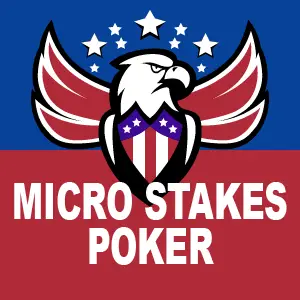Fast Track To Success – Lesson 6

Micro Stakes Poker (6)
- We need to focus on both taking down hands and winning at showdown
- In today’s tighter games, it’s even more important to be aggressive
- We must tailor our aggression to the overall tendencies of our opponents
Two Ways Of Winning Hands
In the last article I spoke of simple odds which relate to the risk and return ratio as far as what we may expect should our hands be shown down. However, a high percentage of hands don’t get shown down, whereas our opponents may all fold and we may win the pot by default as the last person standing. It’s rare that we know that an opponent will never fold unless there are is no more potential for betting, meaning that an opponent is either all in or our action closes the betting, as in the case with looking to call at the river.
So to really have an idea of what to do in reference to our chances of making or losing money with a hand, we really do need to consider both our value equity, measured by pot odds, and our fold equity. This comes up a lot more than many players think, and it isn’t just a matter of trying to figure out the occasional so called semi-bluff where you may have a good flush draw and also have a good chance of taking down the pot.
You Need To Consider Both Value And Fold Equity

So we’re at least going to need to have some sort of decent idea of both value and fold equity. As you may be able to imagine, the calculations that can result can be pretty complex, and the more experienced you become with them the more complex you can make them. However, at the best of times, we have a limited amount of time and resources to use while contemplating a poker decision, and even the most advanced thinking will incorporate some real shortcuts. However, as you are newer players, we definitely need to keep things fairly simple so you don’t get overwhelmed and thus become unable to use the tools accurately or practically.
So what we want to start out with is a simple concept which will have you evaluating whether or not you can just ignore value and go for fold equity. I teach a more advanced version of this in my other series and in a way this one oversimplifies things if you want to be technical about it, but there’s no time for any of that here and we need something really simple.
Exploiting Players Who Fold Too Much
So what this comes down to is looking at the pot odds and deciding if your opponent just plain folds too much for us not to care about anything else. It may surprise you that a lot of players often do. To be able to pull this off though you need to be paying attention to how a player plays. Later on once you start using programs which track player statistics for you, it will be easier to spot trends in player behavior, but for now let’s say we’re just looking to characterize players as loose or tight.
So when betting into a tight player, someone that folds more often than not, there’s absolutely no reason not to pound these people with bets, at least until they adjust. Chances are, at the stakes you should be playing, they won’t adjust that well, but at the same time you don’t want to overdo it and make things too obvious. I would say betting 3 our of 4 times would be fine, and mix up what you have with the time you’re not betting, especially if they tend to look to get aggressive themselves in the face of your being passive and backing off. If so, I’d look to check all my real hands and pound them every time when I don’t have something.
Fold Equity In Action
So let’s say you’re up against a single opponent and they fold half the time when bet into. There is $2 in the pot right now. You’re looking to decide whether you should bet half the pot. If you do, you win the $2 in the pot half the time and the other half of the time, well who cares about that really and we don’t even have to look at it. For every 100 times you do this, you win $100, and lose $50, assuming that when they don’t call the money is lost. You make an instant profit here because of the pot odds, which are paying you 2:1 where you win half of the time at least.
If they fold even more often than this, which players usually do, your profit goes up even more. So say he folds 65% of the time, which a great many tighter players do, now every 100 hands you make 65×2 = $130, and only “lose” $35, so the net profit for you is $95 overall instead of just the $50 in the first example where they only fold half the time.
Now even if they only fold 40% of the time and raise you all in if they don’t, and you fold every time, it’s still profitable to bet every time into them, at least when the bet is half the pot. Now, for every 100 hands, you win $80, and only lose $60, so that’s a meaningful profit right there. However, you won’t be folding every time if he does this, and with your better hands you’re going to take his stack, as if you pick your spots you will win a lot more than you lose here.
You Always Want To Be Selective With Your Aggression
So as you can see, it’s very often profitable to do a lot of betting, which is the main reason why aggressive players do better than passive ones. Now I don’t want to suggest that you become a maniac and just fire out with anything every time, but a lot of players don’t bet enough, and chances are you’re one of them. It all comes down to how our opponents play though, and if you’re up against a loose player who will call you down with anything, you certainly want to be a lot less aggressive with them.
So what can go wrong when you’re too aggressive this way? Well first of all you can bet too often in relation to your opponent’s tendency to fold, and given that your advantage and your profit from this strategy relates to their folding too much, if they don’t fold enough, it will certainly be a mistake. The bigger mistakes occur though by making this one on several streets in increasing amounts. So if you’re betting the $1 into the $2 pot on the flop, and get called by a calling station, on the turn the bet will need to be bigger, in this case $2 if it’s half the pot, and $4 at the river.
So if you show this down and lose more than you win, it’s not just the $1 you were risking initially. You’ve put a total of $7 in the pot now, so the mistake you made initially gets amplified. If you bet bigger than half pot, for instance three quarters or full pot, this gets amplified even more. If it’s full pot for example than it’s $2 plus $6 plus $18 for a total of $26. So you want to be careful not to make mistakes, and especially not to make them over several rounds of betting. We’re going to be looking to beat our opponents out of their money by looking to take advantage of their tendencies to do this, and we want them to be the chumps here, not ourselves.
Make Sure You Focus On Their Tendencies
So this is a real key point in this series, which is to make sure that you’re not compounding your mistakes and looking to take advantage of your opponents’ tendency to compound theirs. So you really need to re-assess the situation as the play develops in the hand. For instance, when we bet out on the flop we want to make sure that if we’re going after fold equity, as discussed in the earlier examples, that the player does indeed fold enough. This will only be a third of the time or more, so the threshold isn’t very high.
Next, if we do get called or raised, then things definitely change here, and we need to make sure that our strategy takes this change into account. So we need to look at what the tendencies of this player are to decide what to do next. This may still involve continuing to bluff if he or she tends to give up on the hand later, for instance. Some players for example will call you on the flop and the turn but fold way too often on the river, perhaps from chasing draws which miss or just being curious to see how the cards end up being dealt. Perhaps the player calls a fair amount of flops but folds a lot on the turn.
In these cases it will be profitable to continue the bluff, and they are usually even more profitable than players just folding the flop, since you make a lot more money from bluffs continued on to later streets. When this happens, we don’t even care if they are too loose on the flop, just as long as they are too tight at some point later on in the hand. Our opponents are said to lack proper hand planning, where they don’t think their overall strategies through enough, and on the other hand we’re thinking ours through and that’s going to be a big advantage to us here.
Whenever we don’t have enough pure fold equity to continue to look to exploit that, we’re going to have to turn to value equity to see if there’s enough of that to make sense of our continuing, a topic I’ll go into in the next session.
Micro Stakes Poker – Fast Track to Success
- Fast Track To Success – Lesson 1
- Fast Track To Success – Lesson 2
- Fast Track To Success – Lesson 3
- Fast Track To Success – Lesson 4
- Fast Track To Success – Lesson 5
- Fast Track To Success – Lesson 6
- Fast Track To Success – Lesson 7
- Fast Track To Success – Lesson 8
- Fast Track To Success – Lesson 9
- Fast Track To Success – Lesson 10
- Fast Track To Success – Lesson 11
- Fast Track To Success – Lesson 12